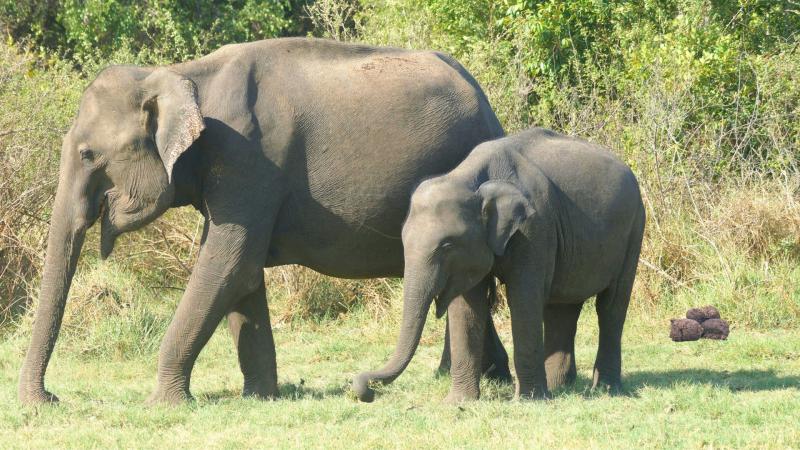
In a new study conducted in the fragmented forest landscape of Kodagu, Karnataka, researchers have developed a reliable method to count Asia’s elephants by analysing DNA from dung samples. The new method was found to outperform traditional counting methods, which often overestimate the population. The research provides the first rigorous validation of a non-invasive genetic technique against a known wild elephant population in Asia, offering a critical new framework for conservation efforts across the continent.
Researchers from Wildlife Institute of India, National Tiger Conservation Authority, WII-NTCA Tiger Cell, Academy of Scientific and Innovative Research (AcSIR), and the Ministry of Environment, Forests and Climate Change (MOEFCC) conducted their study in the Kodagu landscape, with a mix of tropical forests and coffee plantations. The region also harbours an Asian elephant (Elephas maximus) population, whose size is already known through long-term monitoring by the Karnataka Forest Department, including direct counts of semi-captive elephants and GPS collar tracking of two resident wild herds. This field-validated reference point allowed the team to directly compare the accuracy and bias of their new estimation techniques.
Did You Know? The Asian elephant (Elephas maximus) is considered a "keystone species" because it plays a pivotal role in maintaining forest structure and dispersing seeds across South and Southeast Asia and India is home to over 50% of the global Asian elephant population. |
When tested against a known population of 34 elephants in the study area, the conventional method of counting dung piles overestimated the actual number by a factor of six. For decades, line-transect dung surveys have been the standard indirect technique for estimating elephant numbers in dense tropical forests where the animals are hard to see. This method involves estimating the density of dung piles and then converting that number into an elephant population size using assumed rates for how often an elephant defecates and how quickly the dung decays.
Using traditional line-transect dung counts, the team estimated elephant density at 1.27 individuals per square kilometre. This suggests a total population of around 127 elephants. In sharp contrast, the new method, called genetic Spatially Explicit Capture-Recapture (SECR), estimated a density of 0.23 individuals per square kilometre, corresponding to a total abundance of 39 elephants. The confidence interval or the margin of error for the genetic estimate tightly encompassed the actual known population of 34, demonstrating minimal error.
For decades, line-transect dung surveys have been the standard indirect technique for estimating elephant numbers in dense tropical forests where the animals are hard to see. This method involves estimating the density of dung piles and then converting that number into an elephant population size using assumed rates for how often an elephant defecates and how quickly the dung decays. The problem, as the researchers confirmed, is that these defecation and decay rates vary widely by season, habitat, and climate, and using non-local or averaged values can introduce errors of over 50%. In tropical forests, this often leads to an overestimation of the true abundance.
To overcome this, the scientists turned to non-invasive genetic sampling, which acts as a digital mark-recapture system. During the survey period in June and July 2021, field teams opportunistically collected fresh dung samples along the transects. In the laboratory, DNA was extracted from the outer layer of the dung and then genotyped using high-throughput microsatellite sequencing (SSR-Seq). This process identifies individual elephants based on their unique genetic profiles. Of 144 samples collected, 124 were successfully genotyped, yielding 33–34 unique individuals, a near-perfect match to the known population.
Unlike dung counts, the SECR model does not rely on the variable decay or defecation rates. Instead, it uses the individual DNA profiles in the dung to record the location and simultaneously estimate population size, detection probability, and the spatial scale of detection, which reflects the animal's home range. This approach accounts for animal movement within the survey area, preventing the same animal from being counted more than once. It also yields density estimates that are less biased by environmental factors. The genetic analysis also provided valuable evolutionary insights, suggesting signs of genetic diversity and potential fine-scale population substructure or inbreeding.
The genetic SECR approach is robust because it eliminates the reliance on habitat- and climate-sensitive decay rates. Furthermore, the genetic data provides also provides a wealth of biological data beyond a simple enumeration. The method, however, requires a greater per-unit investment than dung counts. There are also logistical challenges, particularly the rapid degradation of DNA in dung in tropical environments, which led to 14% of samples failing to genotype. For these reasons, the researchers suggest a hybrid framework may be the most practical solution: using periodic genetic SECR surveys to calibrate and validate easier, more frequent methods like dung counts or camera traps.
This article was written with the help of generative AI and edited by an editor at Research Matters.